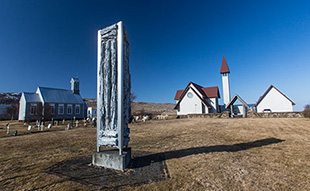West Iceland - the Sagaland, Snaefellsjokull glacier, scenic fjords ...
The area of west Iceland is defined by Hvalfjörður - Hvalfjordur (Whale Fjord) in the south (just outside Reykjavik), the Vestfirðir (Westfjords) in the north and Langjökull (Langjokull) glacier in the east, with the countryside of Borgarfjörður (Borgarfjordur) and Snæfellsnes (Snaefellsnes) peninsula in the middle stretching out westwards. West Iceland has all the natural wonders and unique attractions of Iceland: glaciers, lava formations, waterfalls, geothermal activity, as well as many historical sites.
Borgarfjörður (Borgarfjordur) is Iceland’s second largest lowland area, rich in farming, lakes and rivers for fishing, but also rugged scenery with chasms and waterfalls, with glaciers forming a majestic backdrop on the western rim of the highlands.
History and the Sagas
West Iceland was home to some of the great figures in Iceland’s cultural history. This part of the country is the richest in Saga literature and it's connected with Landnámabók - The Book of Settlements and numerous sagas. West Iceland is the setting of, amongst others, Gunnlaugs saga ormstungu – Gunnlaug’s Saga (The Saga of Gunnlaug Serpent-tongue), Harðar saga – Hordur’s Saga, Laxdæla saga – Laxdaela Saga (The Saga of the People of Laxardal), Egils saga – Egil’s Saga, and Eyrbyggja saga – Eyrbyggja Saga (The Saga of the People of Eyri).
Iceland's great historian, chieftain, poet and author of the Prose Edda and Heimskringla, Snorri Sturluson  (1179-1241), lived in Reykholt where the visitors can see an interesting saga exhibition and the geothermal pool where Snorri took his daily bath. The pool is filled with water from the hot spring Skrifla by means of the original stone aqueduct used in Snorri’s day. Snorrastofa, a culture and medieval centre founded in Snorri's memory, situated in his ancient homestead, manages various research projects, runs a library and provides reception and information.
(1179-1241), lived in Reykholt where the visitors can see an interesting saga exhibition and the geothermal pool where Snorri took his daily bath. The pool is filled with water from the hot spring Skrifla by means of the original stone aqueduct used in Snorri’s day. Snorrastofa, a culture and medieval centre founded in Snorri's memory, situated in his ancient homestead, manages various research projects, runs a library and provides reception and information.
At Eiríksstaðir (Eiriksstadir), there is a replica of a Viking farm. Eiriksstadir was the home of Eiríkur hinn rauði (Erik the Red) who left Iceland to settle in Greenland; and the birthplace of Leifur Eiríksson (Leif Eriksson), who discovered America in the year 1000 AD.
Waterfalls
Some of the amazing sights in West Iceland include the highest waterfall in Iceland, Glymur, located at the bottom of the Hvalfjordur. Glymur cascades down an impressive height of 190 metres. Other beautiful waterfalls are Hraunfossar (Lava waterfalls) and Barnafossar (Children’s waterfalls) in Borgarfjordur. The water in Hraunfossar seeps underground at the periphery of a lava field before coming out at the edge of a birch forested top of a small canyon. The neighbouring waterfall of Barnafossar is just a few hundred metres away.
Lava Tube Caves
West Iceland is very rich in lava tube caves, the largest one being Víðgelmir (Vidgelmir) in Fljótstunga (Fljotstunga), one of the world´s largest, around 198,000 m3 and 1,585 m long. Vidgelmir contains beautiful traces of ice prints, lava flows, stalactites and stalagmites. Other large lava caves in the area include Surtshellir and Stefánshellir (Stefanshellir). Surtshellir is a cave in the Hallmundarhraun lava fields and it is 1,970 m long. Stefanshellir cave is close by; in the same area, but a rock-fall has separated the two. Together, the caves are about 3,500 m long. It is possible to go for guided tours to see the otherworldly ice formations and stalactites inside the caves.
Other Main Attractions
At the tip of Snaefellsnes peninsula, the mystical Snæfellsjökull (Snaefellsjokull) glacier rises almost from the sea level to crown the beaches and sea cliffs brimming with birdlife. Snaefellsjokull National Park is one of Iceland's three national parks.
Coastal villages include Ólafsvík (Olafsvik), a whale watching cruise base, and from Stykkishólmur (Stykkisholmur), visitors can take cruises or a ferry across to Breiðafjörður (Breidafjordur) Bay with its swirling waters, "countless islands" and period-piece houses on Flatey island, once quite a cultural centre.
Hvalfjörður (Hvalfjordur), Whale fjord, is a scenic, mountainous fjord said to be one of the most beautiful in all Iceland. After World War II, a whaling station was started there and was the longest running station in the country.
Borgarnes is the centre of a region steeped in history. Skallagrímur Kveldúlfsson (Skalla-Grim), mentioned both in The Book of Settlements and Egil’s Saga, was the first to settle there and made his home at Borg. Borgarnes derives its name from his great manor, although the headland on which it stands was initially called Digranes.
Deildartunguhver in the Reykholtsdalur valley is the biggest geothermal spring in Europe, if not the world, producing 180 litres per second at 97°C. Both Akranes and Borgarnes are supplied with hot water by this spring. The piping carrying the water to Akranes is 64 km long and to Borgarnes 34 km long.
Langjökull (Langjokull) glacier is Iceland’s second largest glacier, covering 950 km2, and mostly between 1,200 and 1,300 m high, although the highest point is 1,355 m above sea level. Trips by snowmobile, super jeeps and snow trucks are offered up the glacier in summer. There’s a good view to the glacier from Húsafell (Husafell), a popular vacation place for Icelanders. There’s a swimming pool at Husafell as well as a small golf course.
The mountain Grábrók (Grabrok) in the Norðurárdalur (Nordurardalur) valley is the biggest fissure crater of three along a short volcanic crack. There are very good hiking and walking paths up to the crater and it’s well worth the visit - the views from the top over the valley are quite spectacular.